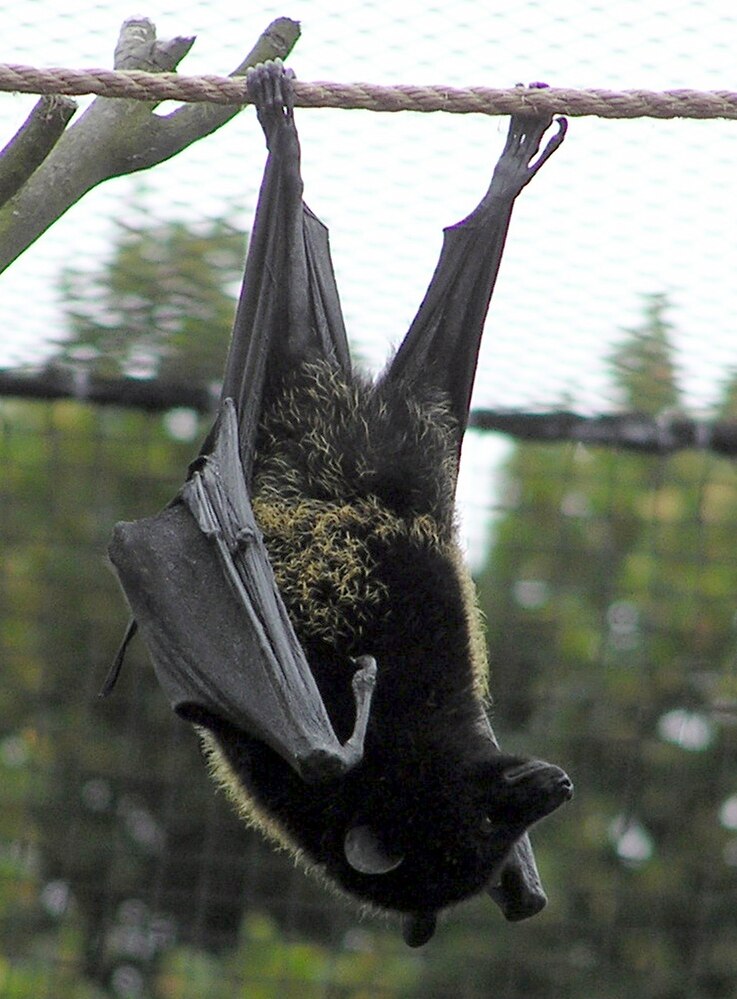How many baby Livingstone’s fruit bats are in a litter?
A Livingstone’s fruit bat (Pteropus livingstonii) usually gives birth to around 1 babies.
Each of those little ones spend around 152 days as a fetus before they are released into the wild. Upon birth, they weight 137 grams (0.3 lbs) and measure 15 cm (0′ 6″). They are a member of the Pteropodidae family (genus: Pteropus). An adult Livingstone’s fruit bat grows up to a size of 34 cm (1′ 2″).
To have a reference: Humans obviously usually have a litter size of one ;). Their babies are in the womb of their mother for 280 days (40 weeks) and reach an average size of 1.65m (5′ 5″). They weight in at 62 kg (137 lbs), which is obviously highly individual, and reach an average age of 75 years.

Livingstone’s fruit bat (Pteropus livingstonii), also called the Comoro flying fox, is a megabat in the genus Pteropus. It is an Old World fruit bat found only in the Anjouan and Mohéli islands in the Union of the Comoros in the western Indian Ocean.It is the largest and rarest bat of all Comorian species. Its preferred habitat is montane forest above 200 metres on Mohéli and above 500 metres on Anjouan, the destruction of which is a major threat to the bat population. As of 2003, the total population was estimated at 1,200 individuals. Other threats to the bats’ survival include storms, hunting, and their struggles to readapt to new habitats.The black-bearded flying fox is believed to be one of the closest relatives of Livingstone’s fruit bats, but experts differ as to whether or not these species belong to the same species group. No subspecies have been recognized.
Other animals of the family Pteropodidae
Livingstone’s fruit bat is a member of the Pteropodidae, as are these animals:
- Seychelles fruit bat with 1 babies per pregnancy
- Minor epauletted fruit bat weighting only 44 grams
- Beaufort’s naked-backed fruit bat weighting only 165 grams
- Moss-forest blossom bat weighting only 20 grams
- Spectacled flying fox with 1 babies per pregnancy
- Black-eared flying fox with 1 babies per pregnancy
- Lesser naked-backed fruit bat weighting only 85 grams
- New Caledonia flying fox weighting only 151 grams
- Halmahera blossom bat weighting only 39 grams
- Ornate flying fox weighting only 335 grams
Animals that share a litter size with Livingstone’s fruit bat
Those animals also give birth to 1 babies at once:
- Big-eared woolly bat
- Thomas’s sac-winged bat
- Painted ringtail possum
- Pale-throated sloth
- Western white-eared giant rat
- Southern giant slender-tailed cloud rat
- Banded palm civet
- Insular single leaf bat
- Asinus
- Woermann’s bat
Animals with the same weight as a Livingstone’s fruit bat
What other animals weight around 733 grams (1.62 lbs)?
- D’Albertis’ ringtail possum weighting 796 grams
- Xerus erythropus weighting 602 grams
- Striped polecat weighting 812 grams
- Brown-tailed mongoose weighting 711 grams
- New England cottontail weighting 814 grams
- Variable pocket gopher weighting 615 grams
- Mountain beaver weighting 806 grams
- Arizona gray squirrel weighting 647 grams
- Southern brown bandicoot weighting 825 grams
- Red-tailed sportive lemur weighting 763 grams
Animals with the same size as a Livingstone’s fruit bat
Also reaching around 34 cm (1′ 2″) in size do these animals:
- Grandidier’s mongoose gets as big as 35.9 cm (1′ 3″)
- Golden-backed uakari gets as big as 40 cm (1′ 4″)
- Brown-eared woolly opossum gets as big as 27.3 cm (0′ 11″)
- Marsh rabbit gets as big as 40.2 cm (1′ 4″)
- Red acouchi gets as big as 36.3 cm (1′ 3″)
- Three-striped night monkey gets as big as 35.8 cm (1′ 3″)
- Eastern barred bandicoot gets as big as 32.3 cm (1′ 1″)
- Black-headed night monkey gets as big as 35.7 cm (1′ 3″)
- New Britain water rat gets as big as 29.2 cm (1′ 0″)
- Mexican fox squirrel gets as big as 28.3 cm (1′ 0″)
